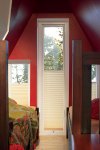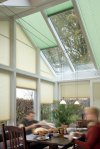Pleated blinds are available in various types, this is due to the type of area that you would like or need to cover. For example:
- Conservatory pleated roof blinds.
- Shaped pleated blinds.
- Electric pleated blinds.
- Crank operated pleated blinds.
Pleated Blinds
Blindology Pleated Blinds - The ideal window dressing solution.
Pleated blinds can be a brilliant way to dress your windows, providing you with an attractive, stylish finish that will be suitable for both traditional and contemporary décors. Blindology's pleated blinds are simple, practical and sleek, and are suitable for any area throughout your home..Our new designer pleated range 2011 is now available, the fabrics are ideal for adding some life, texture and pattern to your windows. Pleated blinds fabrics by Blindology, now offers a large and varied choice which will suit all of your requirements, it even includes a wide range of fabrics that have a solar performance backing, this means that it will help to keep the temperature down in the summer, and retain some of the heat during the winter months. Pleated blinds are sleek, simple and practical, which will neatly fold away, giving you ultimate control of light in your home.
The differing types of pleated blinds Blindology can offer you, can be used in any room of the house, as they can be transparent, semi-opaque or opaque, according to your preference and needs, helping you create interesting light effects in the room.
Pleated blinds are also the perfect blind for conservatories as they can be made to fit the shaped windows in the roof. We have many special performance fabrics designed to keep excess heat out of your conservatory in the summer, and to help to prevent warmth escaping in the winter. Making it much more a room! Rather than a greenhouse or fridge!
Conservatories were made for blinds in mind!
As with any area that has a sheer volume of glass, Pleated blinds will help in giving you the option to compliment these glazed areas, making them the perfect backdrop for a choice, from the huge amount of blind types and styles available. Ranging from a minimal neutral and relaxing retreat, too a retro/funky/modern/bright and vibrant space, that will really make a great and stylish statement, you will be able to create any look you wish for, in your conservatory using Blindology's made-to-measure pleated blinds in the roof and or at the sides.
But just remember:
Blinds don’t only offer good looks. They’re practical too, providing privacy plus they help to regulate the temperature – because when the sun is shining, the heat and glare it creates can really become unbearable.
Where can pleated blinds be used?
Pleated blinds can be installed into any window/glazed area. Normally the main use is in conservatories, however realy speaking there is no limit to where they can be installed.Conservatory comfort.
Your conservatory is an investment and as such you want to maximise the use of it. In most situations the use of purpose-designed and correctly installed pleated blinds will significantly improve the comfort of your conservatory by:- Providing shade and reducing glare
- Reducing the temperature in the Summer and helping to maintain the temperature in the Winter.
- Minimising the effects of harmful UV rays on plant, furnishings and people.
- Reducing heat loss in the winter and cool evenings.
- Reducing ancillary heating and cooling costs.
- Improving the décor and making a style statement.
- Making your conservatory more cosy and private in the evenings.
- Providing privacy.
- Dressing of the window glazed areas, getting rid of the plain dead look.
What is a pleated blind?
Pleated blinds use a fabric, which has been heat-treated in the manufacturing process to form a concertina effect. The fabric is then mounted onto a rail, which allows the blind to be fixed securely, and also contains the mechanism for operating the blind. When fully retracted the blinds take up a minimal amount of space.How do pleated blinds work?
Pleated roof blinds:Rectangular pleated roof blinds: A pleated roof blind consists of three rails. One rail is fixed at either end of the glazing panel. The third rail, which is attached to the pleated fabric, is used to either deploy or retract the blind. To support the fabric when the blind is in the open position tension wires are used.
The blind operated under constant tension. This means that the blind can be opened as far or as little as you wish. The operating cords in the blinds are joined to a spring, which ensures that the right amount of tension is applied at all times.
Shaped pleated roof blinds: Most conservatories involve shaped glazing, which should pose no problem for a qualified pleated blind installer. Pleated fabric is ideal for shaped roof blinds as the “V” profile gives the fabric a unique strength and allows it to be cut to shape without losing its structural integrity. However, over time gravity and heat can affect the pleat retention of the blind. We would recommend on certain blinds that you choose to have the blind “equalised”, this ensures that the blind will hold the pleats at their optimum position and will be evenly spaced, making your roof blinds retain their shape, look more attractive and will last longer. Also it gives your roof blind the advantage of a neater stack of fabric when the blind is retracted, a better fit to the shaped glazing and a smoother blind operation.
Operating pleated roof blinds:
Due to the way pleated blinds are manufactured, using small springs to hold the tension in the operating cords, they are very easy to operate, either manual by the use of an operating pole or by means of motorised pleated roof blinds.
Note: Pleated blinds need to be operated at least once a week to ensure the pleats work effectively.
Pleated window blinds:
Most conservatories have opening windows and doors and pleated window blinds are again the ideal solution because they:
- Can be fitted within the beading of the window.
- Take up a minimal amount of space.
- Are simple to operate.
- Are hardly visible when retracted.
- Can fit to opening windows and doors so the blind moves with the door or window allowing you to have shade but still permitting ventilation.
- Can be fitted to individual windows offering the ultimate control over shading and ventilation.
- Do not take up room on the sill like other blind systems.
How do pleated window blinds work?
Pleated window blinds work on the same principal as a pleated roof blind but as the blind is fitted in the vertical plane, support wires are not required. The clever, constant tension principle means that the blind can be simply raised or lowered to any position. Blindology can install a pleated blind, which can open or stack in any position as neither rail of the blind is fixed. This offers ultimate flexibility.Electric operation:
Electric operation is usually available for most blind styles and shapes and is especially useful for roof blinds which, due to their position, are more difficult to operate than window blinds, there is a minimum size required for this type of blindMost systems use a low voltage tubular motor which is fully contained in the head rail of the blind and it is common that these are operated by radio (wireless) controls. Wireless controls are ideal in conservatories as it reduces the amount of wiring required, as although the blinds still need power from a transformer, the actual operation of the blinds is by radio command. The switches and handsets have an operating range of 200m in open space and unlike infra red controls are unaffected by strong light – essential in conservatory applications.
With electrical operation it is possible to operate an individual blind, group of blinds or all blinds together and the controls can vary from a simple switch to a handset or automatic operation by a timer or light sensor.
Fabrics:
Blindology pleated blinds are manufactured using polyester yarn and are resistant to the extremes of temperature experienced in conservatories as well as having a high resistance to fading. For most of our pleated blind fabrics have a reflective backing or coating, this helps with heat and glare reduction and also protects the back of the fabric from moisture, mildew and debris.Care of pleated blinds
Maintenance:Blindology pleated blinds should not require any ongoing maintenance or adjustment.
Cleaning:
Blindology pleated blinds are made with aluminium rails and these may be wiped with a non-abrasive cleaning solution.
The cleaning of the fabric varies depending on the type of material installed. Most fabrics may be wiped with a damp sponge.
Does it affect my warranty or guarantee of the conservatory?
This we would always ask that you do check with your conservatory installer or company.



No comments:
Post a Comment